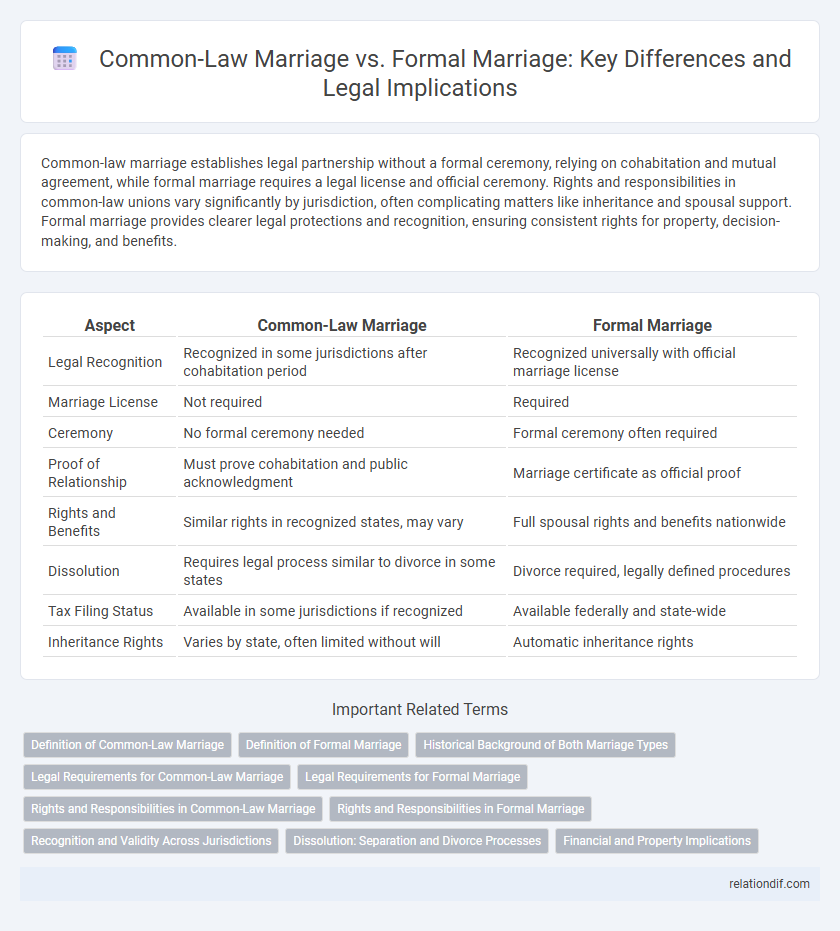Common-law marriage establishes legal partnership without a formal ceremony, relying on cohabitation and mutual agreement, while formal marriage requires a legal license and official ceremony. Rights and responsibilities in common-law unions vary significantly by jurisdiction, often complicating matters like inheritance and spousal support. Formal marriage provides clearer legal protections and recognition, ensuring consistent rights for property, decision-making, and benefits.
Table of Comparison
| Aspect | Common-Law Marriage | Formal Marriage |
|---|---|---|
| Legal Recognition | Recognized in some jurisdictions after cohabitation period | Recognized universally with official marriage license |
| Marriage License | Not required | Required |
| Ceremony | No formal ceremony needed | Formal ceremony often required |
| Proof of Relationship | Must prove cohabitation and public acknowledgment | Marriage certificate as official proof |
| Rights and Benefits | Similar rights in recognized states, may vary | Full spousal rights and benefits nationwide |
| Dissolution | Requires legal process similar to divorce in some states | Divorce required, legally defined procedures |
| Tax Filing Status | Available in some jurisdictions if recognized | Available federally and state-wide |
| Inheritance Rights | Varies by state, often limited without will | Automatic inheritance rights |
Definition of Common-Law Marriage
Common-law marriage is a legally recognized union between two partners who live together and present themselves as married without having formally registered their marriage through a civil or religious ceremony. This type of marriage requires meeting specific state criteria such as cohabitation for a significant period, mutual agreement to be married, and public acknowledgment as spouses. Unlike formal marriages documented by a marriage license, common-law marriages rely on behavioral evidence and intent to establish legal rights and responsibilities.
Definition of Formal Marriage
Formal marriage is a legally recognized union between two individuals, established through a civil or religious ceremony that complies with jurisdictional requirements such as obtaining a marriage license and performing official registration. This type of marriage grants spouses numerous legal rights and responsibilities, including inheritance, tax benefits, and spousal support. Unlike common-law marriage, formal marriage typically requires a public declaration and documentation to validate the partnership under the law.
Historical Background of Both Marriage Types
Common-law marriage originated in English common law as a practical solution for couples cohabiting without formal ceremonies, especially in regions lacking established legal institutions. Formal marriage, rooted in religious and state institutions, dates back thousands of years and has been codified through civil laws and ecclesiastical decrees to regulate property, inheritance, and social status. Both marriage types evolved to address societal needs, with common-law marriage gaining recognition in certain jurisdictions as a valid union, reflecting shifts in social and legal attitudes.
Legal Requirements for Common-Law Marriage
Common-law marriage requires couples to live together for a significant period, present themselves as married, and intend to be married without a formal ceremony or marriage license. Legal recognition of common-law marriage varies by jurisdiction, with some states requiring proof of cohabitation and mutual consent. Unlike formal marriage, common-law couples must often provide evidence of their relationship to gain legal rights such as inheritance, spousal support, and property division.
Legal Requirements for Formal Marriage
Formal marriage requires a legally recognized ceremony performed by an authorized officiant and the issuance of a marriage license from the local government. Couples must meet age requirements, provide valid identification, and often comply with residency or waiting period laws depending on the jurisdiction. Unlike common-law marriage, formal marriage establishes clear legal documentation that simplifies rights related to property, inheritance, and spousal benefits.
Rights and Responsibilities in Common-Law Marriage
Common-law marriage grants partners many of the same legal rights and responsibilities as formal marriage, including property division, inheritance, and spousal support, once specific criteria are met. Unlike formal marriage, these rights often depend on demonstration of cohabitation, intent to be married, and public representation as spouses. Legal recognition of common-law marriage varies by jurisdiction, affecting access to benefits such as health insurance, tax filing status, and decision-making authority in medical emergencies.
Rights and Responsibilities in Formal Marriage
Formal marriage grants legally recognized rights and responsibilities, including spousal inheritance, tax benefits, and healthcare decision-making authority. Couples in formal marriages are entitled to joint property ownership and are obligated to provide financial support to each other. Court systems typically enforce these rights and responsibilities, ensuring protection during divorce or legal disputes.
Recognition and Validity Across Jurisdictions
Common-law marriage is recognized in select jurisdictions where partners meet specific criteria such as cohabitation and presenting themselves as married, while formal marriage requires legal registration and a marriage certificate universally accepted across all jurisdictions. The validity of common-law marriages can vary significantly, often lacking the automatic legal protections granted to formally registered marriages, including property rights and spousal benefits. Formal marriages provide consistent legal recognition internationally, enabling straightforward access to inheritance, tax benefits, and divorce proceedings, which can be complicated or unavailable for common-law couples outside their home jurisdiction.
Dissolution: Separation and Divorce Processes
Common-law marriage dissolution varies significantly from formal marriage, as it often requires proving the relationship's existence through cohabitation and mutual agreement rather than filing for divorce. Formal marriages mandate legal divorce proceedings with court involvement, property division, and potential spousal support determinations. Separation processes in common-law marriages may be less defined legally, complicating asset distribution and custody arrangements compared to the structured procedures available in formal marriages.
Financial and Property Implications
Common-law marriage often grants similar financial and property rights as formal marriage, including shared ownership of assets acquired during the relationship and entitlement to spousal support, depending on jurisdiction. Formal marriage provides clearer legal protections and streamlined processes for property division, inheritance, and tax benefits due to recognized legal documentation. Property acquired before the relationship typically remains separate, but jointly earned income and property are commonly subject to equitable distribution in both marriage types.
common-law marriage vs formal marriage Infographic

 relationdif.com
relationdif.com